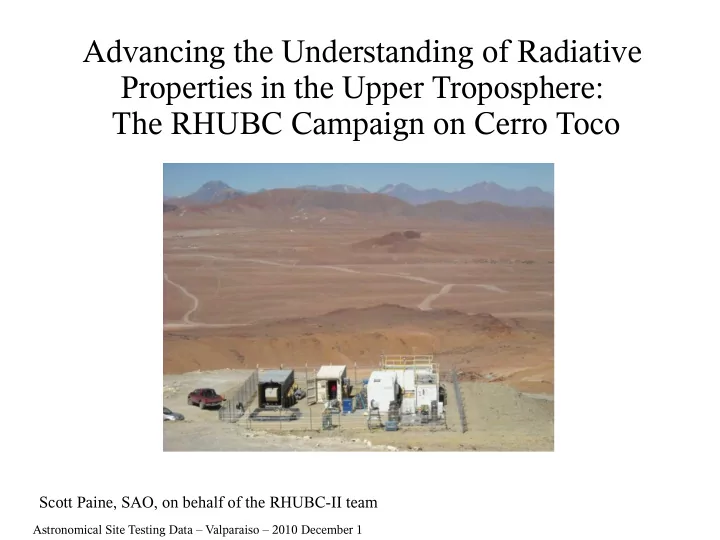

Advancing the Understanding of Radiative Properties in the Upper Troposphere: The RHUBC Campaign on Cerro Toco Scott Paine, SAO, on behalf of the RHUBC-II team Astronomical Site Testing Data – Valparaiso – 2010 December 1
RHUBC-II People Principal Investigators Eli Mlawer, Atmospheric and Environmental Research, Inc. Dave Turner, NOAA Campaign Logistics Jim Mather, Pacific Northwest National Laboratory Kim Nitschke, Los Alamos National Laboratory Collaborating Institutions / Instrument PI's NASA Langley Research Center, USA / Marty Mlynczak Instituto de Fisica Applicata, Italy / Luca Palchetti University of Denver, USA / Tom Hawat University of Cologne, Germany / Susanne Crewell Smithsonian Astrophysical Observatory / Scott Paine Argonne National Laboratory / Maria Cadeddu, Rich Coulter Many others involved in planning, field campaign, and data analysis Astronomical Site Testing Data – Valparaiso – 2010 December 1
Outline ● Background: Atmospheric radiation, water vapor, and climate ● The Radiative Heating in Underexplored Bands Campaigns (RHUBC) ● A case study from RHUBC-II: Radiative closure using submillimeter FTS spectra and radiosonde profiles Astronomical Site Testing Data – Valparaiso – 2010 December 1
Infrared spectral cooling rate (Midlatitude summer, after Clough and Iacono, 1995) ● Radiation, convection, and circulation govern climate. ● Far-IR radiation from mid- to upper troposphere accounts for about half of longwave cooling. (T eff ~ 255 K) ● Accurate radiation modeling is essential for accurate climate modeling. ● Water vapor line and continuum radiation play a central role. Astronomical Site Testing Data – Valparaiso – 2010 December 1
Validation of radiation models for the mid- to upper troposphere is hard: ● Opacity of the lower troposphere hinders measurements. ● Laboratory measurements under appropriate P, T are very difficult. Solution: go to very dry, high site Astronomical Site Testing Data – Valparaiso – 2010 December 1
The Radiative Heating in Underexplored Bands Campaigns (RHUBC) ● Proposed in 2006 by Turner and Mlawer to the Atmospheric Radiation Measurement (ARM) program of the US Department of Energy ● Motivated by: Importance of FIR contribution to outgoing longwave radiance ● Few spectrally-resolved measurements with coincident H 2 O profile data ● Newly-available FIR spectrometers and 183 GHz radiometers ● Availability of ARM infrastructure ● Existence of supported high, dry sites in Chile at tropical latitude ● ● Campaigns: RHUBC-I: ARM North Slope Alaska (NSA) site, Feb-Mar 2007 ● RHUBC-II: Cerro Toco in CONICYT science preserve, Aug-Oct 2009 ● Astronomical Site Testing Data – Valparaiso – 2010 December 1
How dry? RHUBC-I and RHUBC-II radiosonde PWV: Astronomical Site Testing Data – Valparaiso – 2010 December 1
RHUBC-II Instruments (1) ● Fourier transform spectrometers spanning entire thermal infrared: AERI (ARM / Turner) 3.3 μm – 25 μm ● FIRST (NASA / Mlynczak) 6.3 μm – 100 μm ● REFIR-PAD (IFAC – CNR / Palchetti) 7 μm – 100 μm ● SAO-FTS (SAO / Paine) 85 μm – 1000 μm ● FIRST AERI REFIR SAO-FTS Astronomical Site Testing Data – Valparaiso – 2010 December 1
RHUBC-II Instruments (2) ● Multi-channel radiometers: GVRP 15-channel 183 GHz radiometer (ARM / Cadeddu) ● HATPRO 22 GHz / 60 GHz radiometer (Cologne / Crewell) ● GVRP HATPRO Astronomical Site Testing Data – Valparaiso – 2010 December 1
RHUBC-II Instruments (3) ● Atmospheric state: Vaisala RS-92 radiosondes ● Met tower ● ● Sun / Scattered light ASTI solar tracking FTS (U. Denver / Hawat) 1 μm – 5 μm ● ARM MFRSR shadow band radiometers ● MFRSR ASTI Astronomical Site Testing Data – Valparaiso – 2010 December 1
Spectral coverage of entire thermal infrared – with coincident atmospheric state data from sondes (Preliminary data from 2010 Sep 19, 15:30 UT) Astronomical Site Testing Data – Valparaiso – 2010 December 1
Problem: Sondes aren’t perfect ● Sondes give high-resolution profiles for temperature and humidity, but humidity accuracy under dry conditions can be poor. ● Various problems: Dry calibration ● Response lag ● Solar heating ● Data processing ● Manufacturing variations ● ● Miloshevich, et al. 2009 formulated a correction for RS92 sondes based on comparison with chilled-mirror sensor data. Validity for very dry conditions is not clear. Astronomical Site Testing Data – Valparaiso – 2010 December 1
A case study from RHUBC-II – radiative closure between sonde profiles and submillimeter FTS spectra ● Fit forward model to measured spectrum, using just two adjustable parameters: Scaling factor on sonde humidity profile ● Water vapor column in instrument enclosure (~ 1 μm PWV) ● Astronomical Site Testing Data – Valparaiso – 2010 December 1
Zenith Planck T b from SAO FTS Error bars (every 50 th point) reflect cal error and quadrature noise spectrum ● Astronomical Site Testing Data – Valparaiso – 2010 December 1
Two parameter model fit Fit scale factor on sonde RH, small H 2 O layer inside instrument. ● Astronomical Site Testing Data – Valparaiso – 2010 December 1
Fit all spectra with clear sky sonde profiles Little systematic trend vs. total PWV, except at low end. ● Statistical error on fitted scale factor is about 0.5%, based on bootstrap analysis ● Astronomical Site Testing Data – Valparaiso – 2010 December 1
How much information is in the spectrum? Comparison between bootstrap analysis and chi-squared suggests ~100 degrees of ● freedom constrain sonde scaling. Astronomical Site Testing Data – Valparaiso – 2010 December 1
Preliminary comparison of sonde scalings: submillimeter FTS vs. GVRP 183 GHz radiometer (with Mlawer et al., AER) Miloshevich correction helps, but effect is slight. ● More sophisticated sonde RH calibration analysis underway (Turner, Caddedu) ● Astronomical Site Testing Data – Valparaiso – 2010 December 1
Conclusion ● RHUBC-II has provided an unprecedented data set for understanding radiative properties of the upper troposphere. ● Multiple analyses are currently ongoing – showed one example ● Data are available from the ARM archive at www.archive.arm.gov Astronomical Site Testing Data – Valparaiso – 2010 December 1
Recommend
More recommend